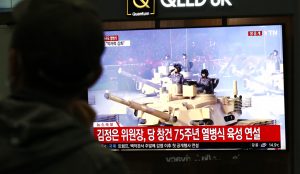By Jacob Parakilas

North Korea may not be good at providing democracy or public goods to its citizens, but when it comes to militarized mass spectacle, few countries can compete. This year’s military parade was no exception: Unusually staged at night, it featured flyovers of combat aircraft lit in bright LED lights, marching battalions of soldiers, formations of rocket artillery and main battle tanks, and of course, a large collection of short, theatre, and long-range ballistic missiles.
The star of the show — previewed by North Korean statements — was a new road-mobile, liquid-fueled intercontinental ballistic missile, the biggest such weapon in the world, which was rolled out on a brand new off-road transporter-erector-launcher (TEL). The rollout of a new ICBM — indeed, the entire parade — was a distinctly analog intervention into a world where defense and security budgets and analytical energy have increasingly been directed towards concepts which are much more difficult to visualize: cybersecurity, information warfare, network-centricity and so on.
Indeed, the aesthetic of a North Korean military parade is nothing if not a throwback. The display of hardware is modeled after a Soviet Victory Day parade. And of course what might be termed strategic pageantry is much older than that. The Royal Navy has been sailing past monarchs for hundreds of years, Roman legions paraded through the capital to celebrate victories, and that probably isn’t the oldest example. The U.S. is uncomfortable with military parades, as Donald Trump can testify, but the overt display of military hardware is a regular feature in American life.
Does it matter? After all, parade-ground maneuvering hasn’t been a relevant tactical skill since the days of the smoothbore musket. State-on-state warfare has become relatively rare; the ongoing fighting between Armenia and Azerbaijan is attracting attention from military theorists because it is unusual to see mechanized state armies in direct conflict with each other, rather than fighting irregular or proxy forces. And much of the Western strategic conversation in the last few years has focused on irregular conflict, grey-zone operations and hybrid scenarios.
We should maintain an appropriate skepticism of military hardware displays, of course. But it is worth taking the nuclear angle seriously. The world still exists at the brink of nuclear catastrophe, and the guardrails are being edged away. The last remaining arms control treaty between the U.S. and Russia, New START, hangs by a thread. The Trump administration, which has withdrawn from a range of other arms control measures, is pushing for a renegotiation to include China on top of Russia and the U.S. — but China, whose arsenal remains the smallest of the three by a significant margin, has little reason to come aboard.
In the meantime, Russia is modernizing its nuclear arsenal while also investing in baroque new capabilities like long-range nuclear torpedoes and nuclear-powered cruise missiles. The U.S. has deployed new variants of existing weapons and even suggested a return to nuclear testing, suspended since 1992. France and the U.K. are investing billions into modernizing their submarine-based deterrents, and while dramatic advancements from Israel, Pakistan or India have been few and far between, there is no sign that they are interested in reducing their arsenals.
Those developments are genuinely important, but against everything else happening in 2020 they end up mostly as background noise. The U.S., U.K., China, Russia and France have all possessed the capability to shatter human civilization for as long as most policymakers and analysts have been alive. It is hard to get news editors or audiences to engage deeply or for long with a computer rendering of a new ballistic missile submarine, even if the submarine in question represents a substantial portion of a nation’s discretionary spending. Even Russia’s outlandish new weapons are written up largely as curiosities — which may be an accurate reflection of their military value — though as a mechanism to gain leverage in arms control negotiations they certainly deserve attention.
And it is not as though the concept of a nuclear exchange is a distant one. As recent revelations indicate, the U.S, and North Korea were closer to a shooting war — potentially involving nuclear weapons — in 2017 than had previously been known. And like any complex system involving humans, machines and communication between adversaries, nuclear deterrence is a fundamentally fallible structure.
That may be the silver lining to Pyongyang’s nighttime parade. In 2020, we barely need a reminder that the world is dark and full of terrors. But amidst all the discussion of novel and emerging threats, a giant ICBM driving into frame seems like as good a reminder as any that we haven’t fully managed the old ones yet either.
No comments:
Post a Comment